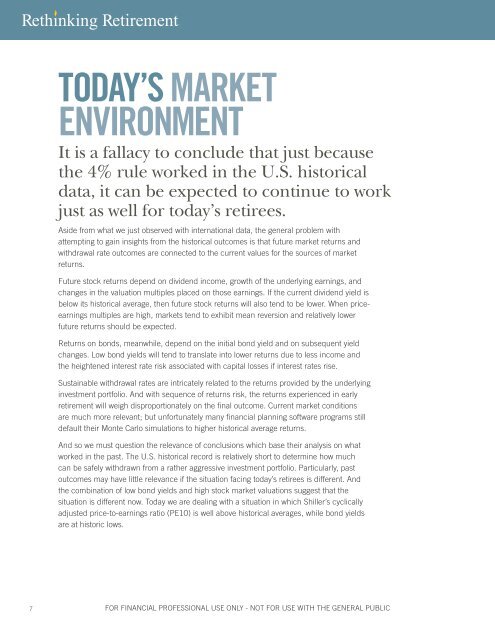Sustainable Withdrawal Rates for New Retirees in 2015
12040-Pfau-Sustainable-Withdrawal-Rates-Whitepaper-
12040-Pfau-Sustainable-Withdrawal-Rates-Whitepaper-
You also want an ePaper? Increase the reach of your titles
YUMPU automatically turns print PDFs into web optimized ePapers that Google loves.
TODAY’S MARKET<br />
ENVIRONMENT<br />
It is a fallacy to conclude that just because<br />
the 4% rule worked <strong>in</strong> the U.S. historical<br />
data, it can be expected to cont<strong>in</strong>ue to work<br />
just as well <strong>for</strong> today’s retirees.<br />
Aside from what we just observed with <strong>in</strong>ternational data, the general problem with<br />
attempt<strong>in</strong>g to ga<strong>in</strong> <strong>in</strong>sights from the historical outcomes is that future market returns and<br />
withdrawal rate outcomes are connected to the current values <strong>for</strong> the sources of market<br />
returns.<br />
Future stock returns depend on dividend <strong>in</strong>come, growth of the underly<strong>in</strong>g earn<strong>in</strong>gs, and<br />
changes <strong>in</strong> the valuation multiples placed on those earn<strong>in</strong>gs. If the current dividend yield is<br />
below its historical average, then future stock returns will also tend to be lower. When priceearn<strong>in</strong>gs<br />
multiples are high, markets tend to exhibit mean reversion and relatively lower<br />
future returns should be expected.<br />
Returns on bonds, meanwhile, depend on the <strong>in</strong>itial bond yield and on subsequent yield<br />
changes. Low bond yields will tend to translate <strong>in</strong>to lower returns due to less <strong>in</strong>come and<br />
the heightened <strong>in</strong>terest rate risk associated with capital losses if <strong>in</strong>terest rates rise.<br />
<strong>Susta<strong>in</strong>able</strong> withdrawal rates are <strong>in</strong>tricately related to the returns provided by the underly<strong>in</strong>g<br />
<strong>in</strong>vestment portfolio. And with sequence of returns risk, the returns experienced <strong>in</strong> early<br />
retirement will weigh disproportionately on the f<strong>in</strong>al outcome. Current market conditions<br />
are much more relevant; but un<strong>for</strong>tunately many f<strong>in</strong>ancial plann<strong>in</strong>g software programs still<br />
default their Monte Carlo simulations to higher historical average returns.<br />
And so we must question the relevance of conclusions which base their analysis on what<br />
worked <strong>in</strong> the past. The U.S. historical record is relatively short to determ<strong>in</strong>e how much<br />
can be safely withdrawn from a rather aggressive <strong>in</strong>vestment portfolio. Particularly, past<br />
outcomes may have little relevance if the situation fac<strong>in</strong>g today’s retirees is different. And<br />
the comb<strong>in</strong>ation of low bond yields and high stock market valuations suggest that the<br />
situation is different now. Today we are deal<strong>in</strong>g with a situation <strong>in</strong> which Shiller’s cyclically<br />
adjusted price-to-earn<strong>in</strong>gs ratio (PE10) is well above historical averages, while bond yields<br />
are at historic lows.<br />
7<br />
FOR FINANCIAL PROFESSIONAL USE ONLY - NOT FOR USE WITH THE GENERAL PUBLIC


